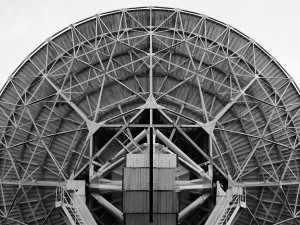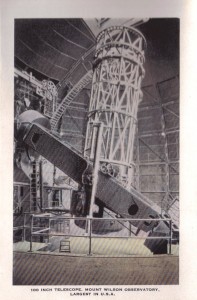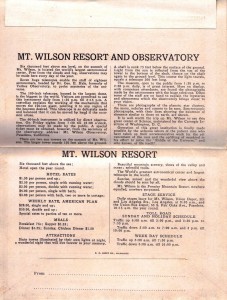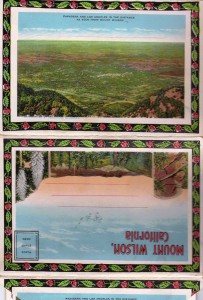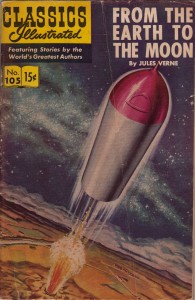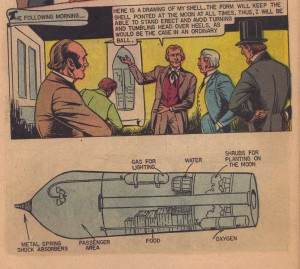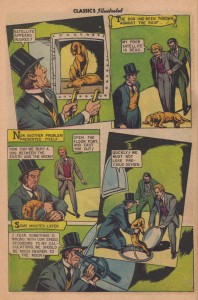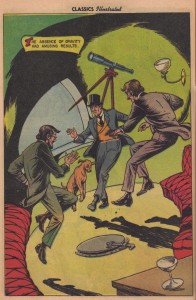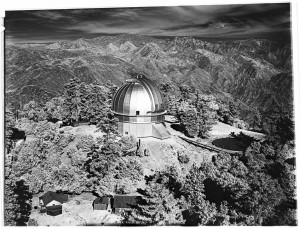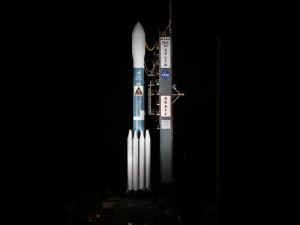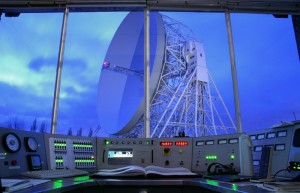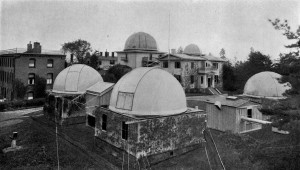Today’s wallpaper features the Knockin Radio Telescope, the Shropshire terminus of the MERLIN/VLBI (Multi-Element Radio Linked InterferometerNetwork/Very Long Baseline Interferometer). Click on the image to reach the download page (iPhone, Blackberry and Full-screen versions available).
Wallpaper Wednesday
28 09 2011Comments : Comments Off on Wallpaper Wednesday
Categories : Instruments, Wallpaper
Mount Wilson II
25 09 2011And speaking of Mount Wilson Observatory, it was featured in a souvenir postcard booklet I picked up in the same antique shop in which I found my Jules Vernes classic comic. Founded in 1904 by George Ellery Hale, the observatory now consists of multiple instruments, both historic (Hale’s 60-inch Telescope, for instance) and “cutting edge” (the Berkeley Interferometer and Georgia State University’s CHARA Array). The observatory is located ideally for tourism: 30 miles from Los Angeles, on the summit of Mount Wilson above Pasadena in the San Gabriel Mountains, just an hour drive from the city. Today, the observatory’s public program is focused on a guided tour that includes a visit to the observing floor of the Hooker 100-inch Telescope.
There is also a museum and a cafe on site so you can make a leisurely day of your visit. If you are feeling a need to spend a lot of money, you can organize a group of your friends (up to 25) and spend a night observing with the 60-inch telescope. As of 2011, the fee was $900 for a half-night of viewing, but you should check the fee schedule for the current rates (also, check out the glossy brochure).
The postcard booklet demonstrates the longevity of the tourist industry on the mountain. At the time of the booklet’s publication, the observatory was reached via the Mount Wilson Toll Road (now a hiking trail). While fully one-half of the descriptive text in the booklet described the wonders of the observatory, Mt. Wilson Hotel (first built 1904, no longer extant) was clearly the planned money-maker in this organization. Road tolls, meals and accommodation went to support the Mt. Wilson Toll Road Company—later the Mt. Wilson Hotel Company. Unfortunately, according to Marv Collins’ article at OldRadio.com, neither the toll road nor the resort were good financial investments, eventually going belly up despite public interest in the observatory.
As far as visual astronomy is concerned, it seems to me that the hotel and the observatory must have been at odds from the very beginning of their relationship. The first attraction listed for the resort? “Sixty towns illuminated by their own lights at night, a wonderful sight that will live forever in your memory.” Did the astronomers working at the observatory sense they were witnessing what would eventually become the almost global problem of light pollution? Or were they just happy to be able to buy a good meal for Sunday dinner at the hotel?
Comments : Comments Off on Mount Wilson II
Categories : Ephemera, Instruments, Observatories
From the Earth to the Moon
21 09 2011I spotted this piece of awesomeness in a local antique store while looking for ways to blow my paycheck. Classics Illustrated was a 169-volume series presenting the work of “the World’s Greatest Authors” in comic book form. The first issue came out in 1941 under the banner of “Classic Comics,” with a name change in 1947 to “Classics Illustrated.” Here we have issue No. 105, featuring Jules Verne’s From the Earth to the Moon (De la Terre à la Lune) in 1865. Actually, it combines together the story line of From the Earth to the Moon and its sequel, Around the Moon (Autour de la Lune), published in 1870.
The Classics Illustrated version was first published in 1953, but according to the inside cover, this is a 1965 reprint (apparently the company stopped printing original editions in 1962). I’m glad it’s a reprint—can you imagine the cognitive dissonance inherent in illustrating a nineteenth-century conception of lunar travel from a post-Project Mercury standpoint? In fact, right around the time this comic hit the newstands, Project Gemini was seeing its first crew launch (Gemini 3, on March 23, 1965). You’d have to pity anyone who had to take Jules Verne’s conception of a lunar vehicle seriously enough to draw it in 1965:
I’m pretty sure gasoliers are not suitable for space travel.
Verne may have been quite forward-thinking in some areas, but what really stands out in this comic is its rendering of post-Civil War society in the United States. I mean, it’s the local gun club that sends the rocket to the moon, not a national aeronautics commission. Had to do something with all the left over munitions, I suppose. I do wonder if the original French version characterized Ardan (the daring fellow who designed the rocket shown above) as “an idiot,” or if that’s an American embellishment.
Another thing: I’d forgotten how creepy Victorian literature could be. Case in point—what do you do when your much beloved dog dies from an asteroid impact? You dump him out the airlock, hopefully without losing all your “precious oxygen”:
Just be glad I didn’t include the frame showing the dog’s corpse floating past the portal.
Jules Verne could also be funny, although it doesn’t particularly come across in this version, unless you think the entire concept of the Baltimore Gun Club sending humans to the moon, with no hope of return, is funny. At least they thought to pack shrubs for planting on the moon’s surface in the cargo hold. But it must be a funny comic, because my partner laughed (more than once) at this page:
You can read From the Earth to the Moon and Around the Moon in English online at Project Gutenberg.
Comments : Comments Off on From the Earth to the Moon
Categories : Ephemera
Wallpaper Wednesday
21 09 2011Today’s wallpaper isn’t so much a wallpaper as much as it is an excuse to link to a fantastic digital library. I spend a great deal of time poking through the USC Digital Library while prepping lectures (on Greene and Greene, for instance), but it only just occurred to me to look for images of observatories like the one featured above of Mount Wilson Observatory in the snow. The library includes several images from Mount Wilson, including a shot of the 60-inch telescope taken c. 1930 and “Men in Suits Inspecting Telescope Apparata” from the same time period.
Comments : Comments Off on Wallpaper Wednesday
Categories : Observatories, Wallpaper
Rocket Pioneers
17 09 2011The National Air and Space Museum has a great online exhibit on international rocket pioneers and the early science fiction films that inspired them. Imaginary rocket ships in silent movies! What could be better?
Follow the museum on twitter @airandspace.
Comments : 1 Comment »
Categories : Ephemera, News
Wallpaper Wednesday
14 09 2011Download this week’s wallpaper to celebrate the successful launch last Saturday (September 9, 2011) of NASA’s Grail mission to map the effects of lunar gravity. Three and a half months from now, twin Grail spacecraft will be following the same orbital path around the mood. As NASA explains:
“As they fly over areas of greater and lesser gravity, caused both by visible features such as mountains and craters and by masses hidden beneath the lunar surface, they will move slightly toward and away from each other. An instrument aboard each spacecraft will measure the changes in their relative velocity very precisely, and scientists will translate this information into a high-resolution map of the Moon’s gravitational field.”
You can watch the GRAIL pre-launch/launch/post-launch videos on NASA’s Youtube channel.
Wallpaper: NASA’s GRAIL twin spacecraft await launch atop a United Launch Alliance Delta II rocket at Cape Canaveral Air Force Station, Fla.
Comments : Comments Off on Wallpaper Wednesday
Categories : Observatories
Frank K. Edmondson
13 09 2011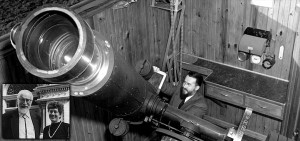
Professor Edmondson at a telescope. Inset with Dr. Caty Pilachowski. Image credit: National Optical Astronomical Observatory News and Reports.
As you can tell from the last few posts, my book collection has grown a bit in the past few weeks, particularly in relation to the history of Harvard Observatory. My partner has been picking up observatory-related books from the local second-hand shop. As it turns out, the books she’s been sorting through were once part of the collection of Frank K. Edmondson, Professor and Chair of Astronomy at Indiana University. Prof. Edmondson did his undergraduate work at IU before earning his Ph.D. from Harvard University, so it’s not unexpected that his library would cover the history of astronomy at either location.
As an undergrad, Edmondson held an assistantship in astronomy, which meant he spent many hours working as a calculator to earn his 25 cents an hour. He was also responsible for opening and managing the Kirkwood Observatory during the weekly public sessions and nightly class meetings. This was on top of his coursework, which was mostly independent study because he was the only astronomy major at IU at the time. He studied almost exclusively under Prof. Wilbur A. Cogshall (see my discussion of the Knightridge Observatory and the Kirkwood Observatory) because, as he stated in an interview conducted in 1977, “Cogshall was the astronomy department.”[1] The 1919 University Bulletin bears out this statement: all fourteen course offerings were taught by Cogshall.[2]
I’ve commented before on the tangled relationships between astronomers and observatories in the U.S. at the end of the nineteenth-beginning of the twentieth century in the United States. University of Washington had close ties with Lick Observatory; Yerkes, Mount Wilson, Palomar, and Hale Solar observatories were tied together through George Ellery Hale; Alvan Clark & Sons designed refracting lenses for the Cincinnati Observatory Center, Yerkes, and Lick Observatory; Warner & Swasey Company built the telescopes at the Lick, Kirkwood, Yerkes and University of Illinois observatories; and so on. Edmondson’s description of his student years at IU brings these interconnections to the forefront as well.
When John Miller (director of the Kirkwood Observatory from 1901-06) began to do double star work in Indiana, he brought on board Wilbur Cogshall, who had been working in Flagstaff as an assistant to T.J.J. See on his double star program. Soon after Cogshall’s arrival, V.M. Slipher (an astronomer originally from Mulberry, Indiana, who is credited with discovering rotational motion in spiral nebulae) graduated from IU. Cogshall used his contacts and got him a job at Flagstaff. The next year (1902), C.O. Lampland graduated from IU and headed off to Flagstaff as well, at Cogshall’s recommendation. E.C. Slipher, the astronomer noted for his observations of Mars and V.M.’s younger brother, followed the same pattern: graduate from IU, head to Lowell Observatory in Flagstaff. Edmondson’s interviewer credited Lowell with bringing together a very “interesting” (and productive) group of scientists at Flagstaff, but Edmondson corrected that assumption, noting that “Yes, well, Cogshall — unless Cogshall had been there, Lowell would never have known about Indiana University, or Slipher or Lampland, if Cogshall had not come there.”
[Interviewer]: “I see, so in a way, it was Cogshall who built the observatory, as far as the staff was concerned.”
[Edmondson]: “That’s right. That’s right. — The three members of the staff, really, when I went out there — well, Arthur Adel was there, I guess, and Clyde Tombaugh — but the three senior members, the two Sliphers and Lampland, were all from Indiana. Then Arthur Adel had gone out there to work with Slipher on planetary spectra, and Tombaugh was there, of course. So your senior staff, for a long period of time, were 100 percent Indiana. As you say, Cogshall built the observatory staff, and that’s it.”
Go, Hoosiers!
The oral histories at the Niel Bohr Library and Archives are priceless. I’m looking forward to digging into Edmondson’s transcript more deeply, particularly for the year he was involved with the development of the NRAO and Green Bank as an NSF officer.
————————————————-
[1] Interview conducted with Edmondson by David DeVorkin in Edmondson’s Office, Swain Hall, Indiana University, 21 April, 1977.
[2] Cogshall had a little bit of help with the teaching. As Edmondson recalls, “K.P. Williams, who was in the mathematics department, taught orbit calculation. Agnes E. Wells, who was dean of women, who had a PhD in astronomy from Michigan, was in the mathematics department, her PhD was in astronomy from Michigan, and she taught history of astronomy. So history of astronomy was Agnes Wells, and orbit calculation was K.P. Williams, and all the rest of the astronomy was Cogshall.”
Comments : Comments Off on Frank K. Edmondson
Categories : Kirkwood Observatory, Knightridge Observatory, Observatories, Warner and Swasey
Wallpaper Wednesday
7 09 2011In a slightly delayed celebration of Bernard Lovell’s 98th birthday, today’s wallpaper gives us an inside (literally) look at the 76-meter Lovell Telescope at Jodrell Bank.
Comments : Comments Off on Wallpaper Wednesday
Categories : Observatories, Wallpaper
Harvard Observatory II
6 09 2011After reading my last post on Harvard Observatory, my partner gave me a follow-up birthday present, The Harvard College Observatory: The First Four Directorships, 1839-1919, by Bessie Zaban Jones and Lyle Gifford Boyd (1971). It covers a time period slightly too early to include Jenka Mohr’s most active years at the observatory, but it does include a photo of December 31, 1929, performance of “The Observatory Pinafore,” for which she played the violin. Notice the fantastic image of Saturn on the back wall:
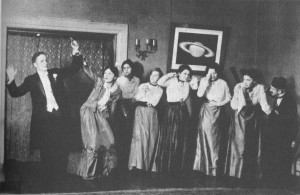
Harvard Pinafore, December 31, 1929. L to R: "Prof. Rogers" (Percy M. Milliman); "Josephine" (Cecila H. Payne): "Lady computers" (Henrietta Swope, Mildred Shapley, Helen B. Sawyer, Sylvia Mussels, Adelaide Ames); "Prof. Searle" (Leon Campbell, Sr. )
At any rate, I’m slowly making my way through the book. First, I had to study the 57 illustrations. After that, I skimmed Chapter XI, “A Field for Women,” hoping to find some trace of Mohr’s earliest days at the observatory (her name wasn’t mentioned). Now I’m starting from the beginning, Chapter I, “Before the Observatory.”
I mention this because this chapter brought me to an intellectual halt on its first page. My own research focuses on the eighteenth century and really has nothing to do with American observatories—my last two projects dealt with India and England, with occasional forays into France, Austria, Bavaria and Portugal. Which is to say, I don’t spend a lot of time thinking about the direction taken by American astronomy during the seventeenth century. Honestly, it never occurred to me that there was a point at which the American astronomy curriculum switched from a Ptolemaic worldview to a Copernican. In my mind, that was something that happened in Europe (and for my work, India), well before a firm university tradition was established in North America.
But as early as 1642, the “Laws, Liberties and Orders of Harvard College” were offering astronomy as part of the curriculum. By 1659, Harvard was leaning fairly strongly toward the Copernican system, as evidenced by the explanation of it in the New England Almanac, written by the Harvard graduate, Zechariah Brigden. Spending so much intellectual time in the Euro-Asian eighteenth century has caused me not only to forget how early Harvard was established (1636), but also that, despite a decided emphasis on Puritan learning and ideals, it had strong ties to Cambridge University and its tradition of scientific education.
And speaking of Copernicus, I have just started reading an advance copy of Dava Sobel’s A More Perfect Heaven: How Copernicus Revolutionized the Cosmos (out next month in the U.S.). I’ll let you know my take on the embedded play after I finish the book.
Comments : Comments Off on Harvard Observatory II
Categories : Observatories
